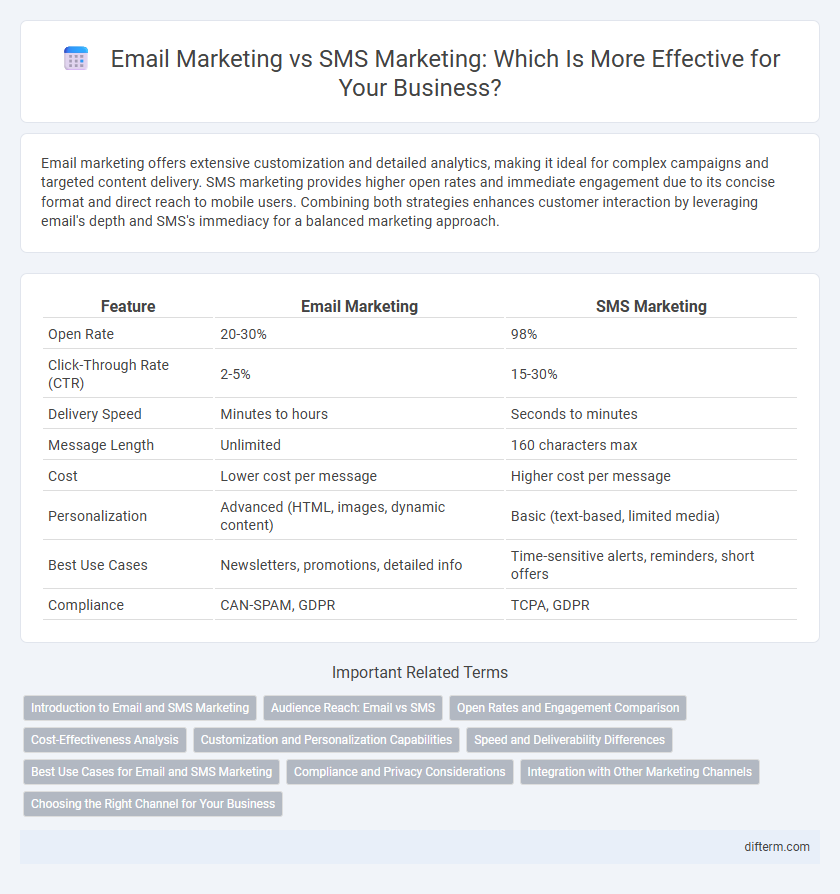Email marketing offers extensive customization and detailed analytics, making it ideal for complex campaigns and targeted content delivery. SMS marketing provides higher open rates and immediate engagement due to its concise format and direct reach to mobile users. Combining both strategies enhances customer interaction by leveraging email's depth and SMS's immediacy for a balanced marketing approach.
Table of Comparison
| Feature | Email Marketing | SMS Marketing |
|---|---|---|
| Open Rate | 20-30% | 98% |
| Click-Through Rate (CTR) | 2-5% | 15-30% |
| Delivery Speed | Minutes to hours | Seconds to minutes |
| Message Length | Unlimited | 160 characters max |
| Cost | Lower cost per message | Higher cost per message |
| Personalization | Advanced (HTML, images, dynamic content) | Basic (text-based, limited media) |
| Best Use Cases | Newsletters, promotions, detailed info | Time-sensitive alerts, reminders, short offers |
| Compliance | CAN-SPAM, GDPR | TCPA, GDPR |
Introduction to Email and SMS Marketing
Email marketing leverages targeted messages sent directly to users' inboxes, offering rich content capabilities and detailed analytics to optimize campaigns. SMS marketing delivers concise, high-impact messages with exceptional open rates, fostering immediate engagement and prompt responses. Both channels utilize personalization and segmentation to maximize customer reach and conversion rates in digital marketing strategies.
Audience Reach: Email vs SMS
Email marketing offers a broad audience reach with over 4 billion global users, making it ideal for detailed content and segmented campaigns. SMS marketing reaches nearly 5 billion mobile phone users worldwide, ensuring immediate message delivery and higher open rates, often exceeding 90%. Combining both channels maximizes audience engagement by leveraging email's depth and SMS's immediacy.
Open Rates and Engagement Comparison
Email marketing typically shows open rates ranging from 15% to 25%, while SMS marketing boasts much higher open rates, often exceeding 90%. Engagement through SMS is significantly higher due to immediate delivery and shorter, more direct messages, resulting in quicker customer response times. Brands leveraging SMS campaigns frequently see conversion rates up to 45%, outperforming email marketing's average conversion rate of 6% to 10%.
Cost-Effectiveness Analysis
Email marketing typically offers a lower cost per message with potential for high ROI through targeted campaigns and automation tools, making it ideal for budget-conscious marketers. SMS marketing, while often more expensive per contact, delivers significantly higher open and response rates, leading to faster customer engagement and conversion. Balancing email's affordability with SMS's immediacy allows businesses to optimize marketing expenditures based on campaign goals and audience behavior.
Customization and Personalization Capabilities
Email marketing offers advanced customization and personalization features, allowing marketers to tailor content using dynamic templates, segmented lists, and detailed behavioral data for individual recipients. SMS marketing, while more limited in character count, excels in immediate, straightforward personalization through click-to-action links and timely, location-based messaging. Both channels leverage user data differently: email emphasizes rich, multimedia customization, whereas SMS prioritizes concise, personalized engagement for quick responses.
Speed and Deliverability Differences
Email marketing often experiences delays due to spam filters and varying server response times, resulting in slower message delivery. SMS marketing boasts near-instantaneous delivery rates, with most messages reaching recipients within seconds, enhancing time-sensitive campaign effectiveness. High deliverability rates of SMS, typically above 95%, contrast with email's average deliverability, which can drop below 85% due to inbox filtering and user behavior.
Best Use Cases for Email and SMS Marketing
Email marketing excels in delivering detailed content, nurturing long-term customer relationships, and supporting complex campaigns like newsletters and product launches. SMS marketing is highly effective for immediate, time-sensitive messages such as flash sales, appointment reminders, and personalized alerts. Combining email for in-depth communication with SMS for urgent, direct engagement maximizes overall marketing impact and customer responsiveness.
Compliance and Privacy Considerations
Email marketing and SMS marketing both require strict adherence to regulations like GDPR, CAN-SPAM, and TCPA to protect consumer privacy and avoid hefty fines. Email marketing demands clear opt-in processes and easy unsubscribe options, while SMS marketing requires explicit written consent and careful message frequency to prevent complaints. Companies must implement robust data security measures and transparent privacy policies to maintain trust and ensure compliance across both channels.
Integration with Other Marketing Channels
Email marketing seamlessly integrates with social media platforms and content marketing by allowing automated drip campaigns and personalized messaging based on user behavior across channels. SMS marketing complements digital strategies by providing instant, high-open-rate notifications that can trigger actions in email funnels or app engagements. Combining both channels enhances cross-channel attribution and delivers a unified customer experience through synchronized messaging and data-driven targeting.
Choosing the Right Channel for Your Business
Email marketing offers detailed content, personalization, and robust analytics, making it ideal for nurturing leads and building long-term customer relationships. SMS marketing provides immediate, high open rates and direct engagement, perfect for time-sensitive promotions and urgent updates. Selecting the right channel depends on your business goals, target audience preferences, and campaign objectives to maximize ROI and customer engagement.
Email marketing vs SMS marketing Infographic

 difterm.com
difterm.com